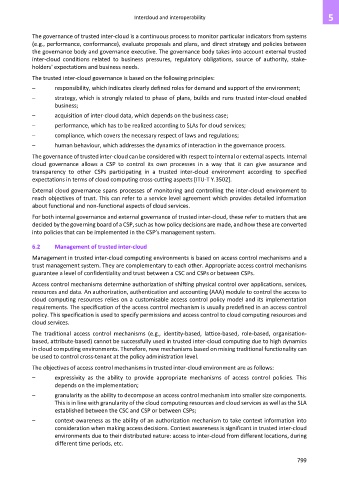Page 807 - Cloud computing: From paradigm to operation
P. 807
Intercloud and interoperability 5
The governance of trusted inter-cloud is a continuous process to monitor particular indicators from systems
(e.g., performance, conformance), evaluate proposals and plans, and direct strategy and policies between
the governance body and governance executive. The governance body takes into account external trusted
inter-cloud conditions related to business pressures, regulatory obligations, source of authority, stake-
holders' expectations and business needs.
The trusted inter-cloud governance is based on the following principles:
– responsibility, which indicates clearly defined roles for demand and support of the environment;
– strategy, which is strongly related to phase of plans, builds and runs trusted inter-cloud enabled
business;
– acquisition of inter-cloud data, which depends on the business case;
– performance, which has to be realized according to SLAs for cloud services;
– compliance, which covers the necessary respect of laws and regulations;
– human behaviour, which addresses the dynamics of interaction in the governance process.
The governance of trusted inter-cloud can be considered with respect to internal or external aspects. Internal
cloud governance allows a CSP to control its own processes in a way that it can give assurance and
transparency to other CSPs participating in a trusted inter-cloud environment according to specified
expectations in terms of cloud computing cross-cutting aspects [ITU-T Y.3502].
External cloud governance spans processes of monitoring and controlling the inter-cloud environment to
reach objectives of trust. This can refer to a service level agreement which provides detailed information
about functional and non-functional aspects of cloud services.
For both internal governance and external governance of trusted inter-cloud, these refer to matters that are
decided by the governing board of a CSP, such as how policy decisions are made, and how these are converted
into policies that can be implemented in the CSP’s management system.
6.2 Management of trusted inter-cloud
Management in trusted inter-cloud computing environments is based on access control mechanisms and a
trust management system. They are complementary to each other. Appropriate access control mechanisms
guarantee a level of confidentiality and trust between a CSC and CSPs or between CSPs.
Access control mechanisms determine authorization of shifting physical control over applications, services,
resources and data. An authorization, authentication and accounting (AAA) module to control the access to
cloud computing resources relies on a customisable access control policy model and its implementation
requirements. The specification of the access control mechanism is usually predefined in an access control
policy. This specification is used to specify permissions and access control to cloud computing resources and
cloud services.
The traditional access control mechanisms (e.g., identity-based, lattice-based, role-based, organisation-
based, attribute-based) cannot be successfully used in trusted inter-cloud computing due to high dynamics
in cloud computing environments. Therefore, new mechanisms based on mixing traditional functionality can
be used to control cross-tenant at the policy administration level.
The objectives of access control mechanisms in trusted inter-cloud environment are as follows:
– expressivity as the ability to provide appropriate mechanisms of access control policies. This
depends on the implementation;
– granularity as the ability to decompose an access control mechanism into smaller size components.
This is in line with granularity of the cloud computing resources and cloud services as well as the SLA
established between the CSC and CSP or between CSPs;
– context-awareness as the ability of an authorization mechanism to take context information into
consideration when making access decisions. Context awareness is significant in trusted inter-cloud
environments due to their distributed nature: access to inter-cloud from different locations, during
different time periods, etc.
799

